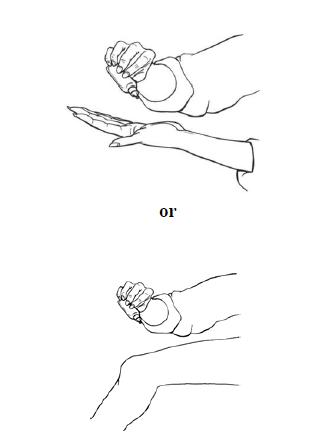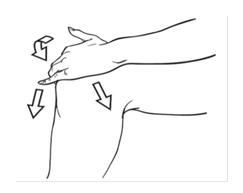Medication Guide for Nonsteroidal Anti-inflammatory Drugs (NSAIDs)
What is the most important information I should know about medicines called Nonsteroidal Anti-inflammatory Drugs (NSAIDs)?
NSAIDs can cause serious side effects, including:
-
Increased risk of a heart attack or stroke that can lead to death . This risk may happen early in treatment and may increase:
- with increasing doses of NSAIDs
- with longer use of NSAIDs
Do not take NSAIDs right before or after a heart surgery called a "coronary artery bypass graft (CABG)."
Avoid taking NSAIDs after a recent heart attack, unless your healthcare provider tells you to. You may have an increased risk of another heart attack if you take NSAIDs after a recent heart attack.
-
Increased risk of bleeding, ulcers, and tears (perforation) of the esophagus (tube leading from the mouth to the stomach), stomach and intestines:
- anytime during use
- without warning symptoms
- that may cause death
The risk of getting an ulcer or bleeding increases with:
- past history of stomach ulcers, or stomach or intestinal bleeding with use of NSAIDs
- taking medicines called "corticosteroids", "anticoagulants", "SSRIs", or "SNRIs"
- increasing doses of NSAIDs
- older age
- longer use of NSAIDs
- poor health o smoking
- advanced liver disease
- drinking alcohol
- bleeding problems
- exactly as prescribed
- at the lowest dose possible for your treatment
- for the shortest time needed
NSAIDs are used to treat pain and redness, swelling, and heat (inflammation) from medical conditions such as different types of arthritis, menstrual cramps, and other types of short-term pain.
Who should not take NSAIDs?
Do not take NSAIDs:
- if you have had an asthma attack, hives, or other allergic reaction with aspirin or any other NSAIDs.
- right before or after heart bypass surgery.
Before taking NSAIDs, tell your healthcare provider about all of your medical conditions, including if you:
- have liver or kidney problems
- have high blood pressure
- have asthma
- are pregnant or plan to become pregnant. Taking NSAIDs at about 20 weeks of pregnancy or later may harm your unborn baby. If you need to take NSAIDs for more than 2 days when you are between 20 and 30 weeks of pregnancy, your healthcare provider may need to monitor the amount of fluid in your womb around your baby. You should not take NSAIDs after about 30 weeks of pregnancy.
- are breastfeeding or plan to breast feed.
Tell your healthcare provider about all of the medicines you take, including prescription or over-the-counter medicines, vitamins or herbal supplements. NSAIDs and some other medicines can interact with each other and cause serious side effects. Do not start taking any new medicine without talking to your healthcare provider first.
What are the possible side effects of NSAIDs?
NSAIDs can cause serious side effects, including:
See "What is the most important information I should know about medicines called Nonsteroidal Anti-inflammatory Drugs (NSAIDs)?"
- new or worse high blood pressure
- heart failure
- liver problems including liver failure
- kidney problems including kidney failure
- low red blood cells (anemia)
- life-threatening skin reactions
- life-threatening allergic reactions
- Other side effects of NSAIDs include: stomach pain, constipation, diarrhea, gas, heartburn, nausea, vomiting, and dizziness.
Get emergency help right away if you get any of the following symptoms:
- shortness of breath or trouble breathing
- slurred speech
- chest pain
- swelling of the face or throat
- weakness in one part or side of your body
Stop taking your NSAID and call your healthcare provider right away if you get any of the following symptoms:
- nausea
- vomit blood
- more tired or weaker than usual
- there is blood in your bowel movement or it is black and sticky like tar
- diarrhea
- itching
- unusual weight gain
- your skin or eyes look yellow
- skin rash or blisters with fever
- indigestion or stomach pain
- swelling of the arms, legs, hands and feet
- flu-like symptoms
If you take too much of your NSAID, call your healthcare provider or get medical help right away.
These are not all the possible side effects of NSAIDs. For more information, ask your healthcare provider or pharmacist about NSAIDs.
Call your doctor for medical advice about side effects. You may report side effects to Viona Pharmaceuticals Inc. at 1-888-304-5011 or FDA at 1-800-FDA-1088.
Other information about NSAIDs:
- Aspirin is an NSAID but it does not increase the chance of a heart attack. Aspirin can cause bleeding in the brain, stomach, and intestines. Aspirin can also cause ulcers in the stomach and intestines.
- Some NSAIDs are sold in lower doses without a prescription (over-the-counter). Talk to your healthcare provider before using over-the-counter NSAIDs for more than 10 days.
General information about the safe and effective use of NSAIDs
Medicines are sometimes prescribed for purposes other than those listed in a Medication Guide. Do not use NSAIDs for a condition for which it was not prescribed. Do not give NSAIDs to other people, even if they have the same symptoms that you have. It may harm them.
If you would like more information about NSAIDs, talk with your healthcare provider. You can ask your pharmacist or healthcare provider for information about NSAIDs that is written for health professionals.
Please address medical inquiries to, (MedicalAffairs@zydususa.com) Tel.: 1-877-993-8779.
This Medication Guide has been approved by the U.S. Food and Drug Administration.
Manufactured by:
Cadila Healthcare Ltd.
Changodar, Ahmedabad, India
Distributed by:
Viona Pharmaceuticals Inc.
Cranford, NJ 07016
Rev: 11/20
Instructions for Use
Diclofenac Sodium Topical Solution USP, 1.5% w/w
Read the Medication Guide that comes with diclofenac sodium topical solution first. Be sure that you read, understand and follow these Instructions for Use before you use diclofenac sodium topical solution for the first time.
Important: For use on the skin only (topical). Do not get diclofenac sodium topical solution in your eyes, nose or mouth.
Before you use Diclofenac sodium topical solution:
- Apply diclofenac sodium topical solution exactly as your healthcare provider tells you. Talk with your healthcare provider or pharmacist if you are not sure.
- Only use diclofenac sodium topical solution to treat pain from osteoarthritis in your knee or knees.
- Apply diclofenac sodium topical solution on clean, dry skin that does not have any cuts, infections or rashes.
- Use diclofenac sodium topical solution 4 times each day on your knee or knees as prescribed.
- Your total dose for each knee is 40 drops of diclofenac sodium topical solution, each time you use it.
- If you get diclofenac sodium topical solution in your eyes, rinse your eyes right away with water or saline. Call your healthcare provider if your eyes are irritated for more than one hour.
Steps for using Diclofenac sodium topical solution:
Step 1. Wash your hands with soap and water before applying diclofenac sodium topical solution.
Step 2. Put 10 drops of diclofenac sodium topical solution either on your hand or directly on your knee (see Figure A).

Step 3. Spread diclofenac sodium topical solution evenly on the front, back and sides of your knee (see Figures B and C). Repeat steps 2 and 3, three times so that your knee is completely covered with a total of 40 drops of diclofenac sodium topical solution.


Step 4. If your healthcare provider has prescribed diclofenac sodium topical solution for both knees, repeat steps 2 and 3 for the other knee.
After you use Diclofenac sodium topical solution:
- Wash your hands with soap and water right away after applying diclofenac sodium topical solution.
- touch the treated knee or allow another person to touch the knee treated with diclofenac sodium topical solution until your knee is completely dry.
- cover your knee with clothing until your knee is completely dry.
- put sunscreen, insect repellant, lotion, moisturizer, cosmetics, or other topical medicines on your knee until it is completely dry.
- take a shower or a bath for at least 30 minutes after you put diclofenac sodium topical solution on your knee.
- use heating pads or cover the treated area with bandages where you have applied diclofenac sodium topical solution.
- use sunlamps and tanning beds. Protect your treated knee from sunlight. Wear clothes that cover your skin if you have to be in sunlight.
How should I store Diclofenac sodium topical solution?
- Store diclofenac sodium topical solution between 68°F to 77°F (20°C to 25°C). Keep diclofenac sodium topical solution and all medicines out of the reach of children.
# are trademarks of respective owners.
This Instructions for Use has been approved by the U.S. Food and Drug Administration.